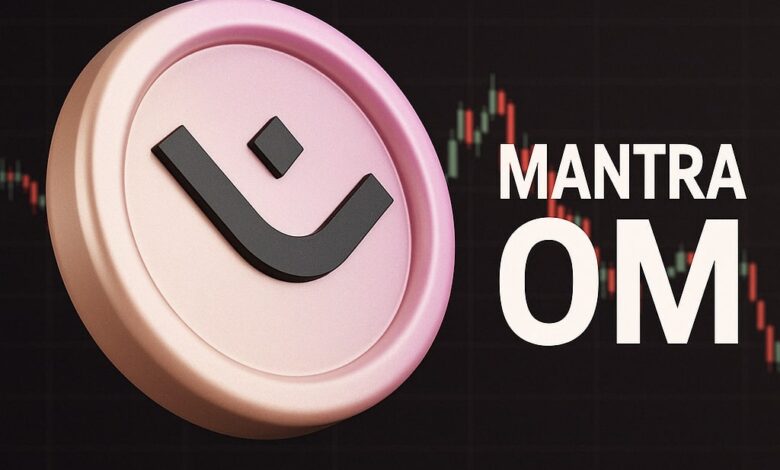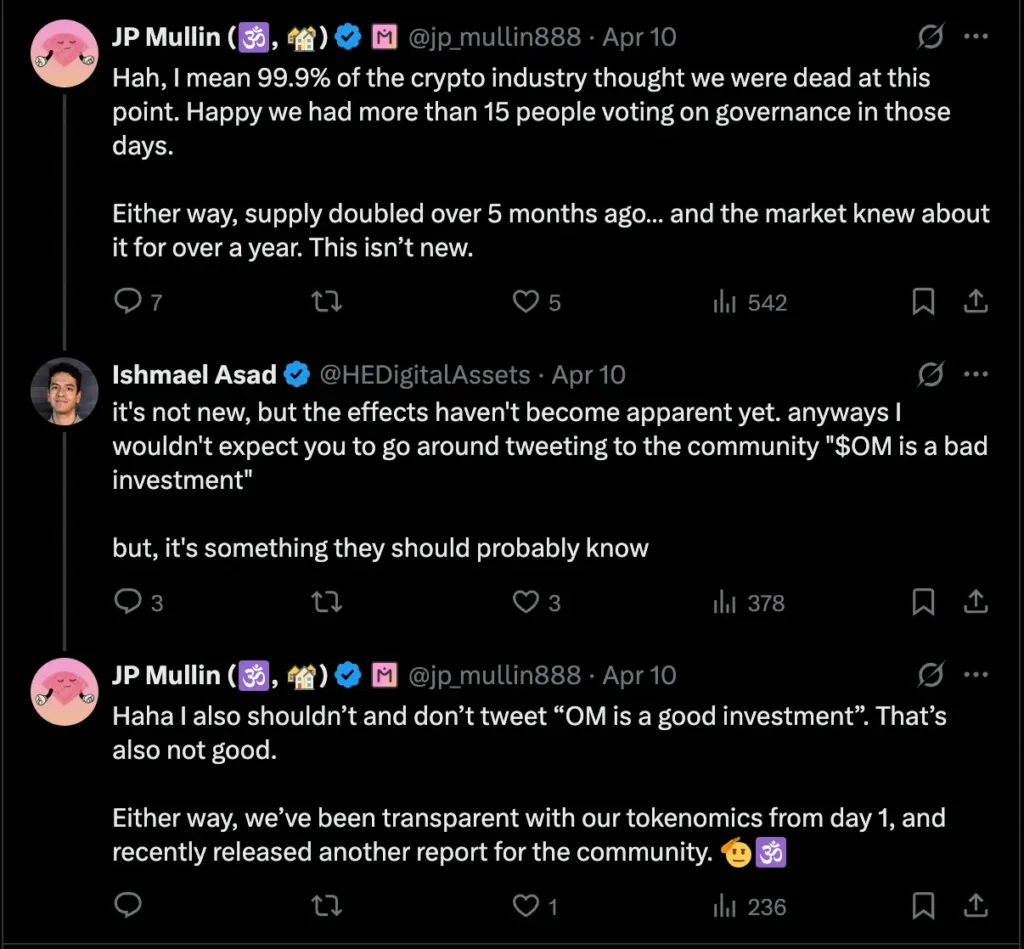
John Patrick Mullin, co-founder of Mantra, says he was fast asleep in his hotel room when the OM token began its dramatic nosedive.
By the time he was woken up, the damage was done: the token that powered his blockchain project focused on real-world assets had plunged more than 80%, erasing billions in paper value and leaving the crypto world scrambling for answers.

In an exclusive interview with Coinage, Mullin attributed the collapse to “massive forced liquidations… in a low liquidity environment on a Sunday night.” But as questions swirl around how it happened so quickly, the more sobering truth may lie in decisions made long before the weekend crash — decisions about token design, liquidity, and governance that echo across the broader crypto landscape.
The Collapse
Mullin, his team, and key investors have all maintained that the OM selloff wasn’t the result of insider activity, but rather a cascade triggered by large liquidations on a single, unnamed exchange.
“These were all clean, fresh, unmarked wallets,” Mullin said. “I label all the wallets that I’m aware of on Etherscan so I can easily track everything.”
What set Mantra apart, however, was the dual-token history baked into its architecture. In addition to OM tokens on its own Layer-1 blockchain launched last year, millions more remained active as ERC-20 tokens on Ethereum. These could be bridged across various networks — including Polygon, Base, and Mantra’s own chain — enabling a complex web of liquidity that, under stress, became a vulnerability.
The project’s reliance on multiple market makers — some of whom were also investors — to manage liquidity across offshore exchanges only added to the uncertainty. When prices began to unravel, they did so quickly.
Binance, which had listed OM, later issued a statement clarifying that it had flagged changes to Mantra’s tokenomics months earlier. “Since January this year, Binance has also issued a pop-up warning for $OM on its spot trading page to inform users that the token has undergone significant changes to its tokenomics increasing its supply,” the exchange said in a post on X.
Mullin rejected any implication that Mantra had manipulated the token’s price.
“We ever engaged in any sort of… pumping of the price or pumping of the token with our market making partners. That is just not how it works,” he said.
“I don’t think… the positions that [market makers] had were capable of handling this massive forced selling.”
Trouble in the Foundation
The collapse has prompted uncomfortable questions, including whether the warning signs were visible — and ignored.
A key moment came in February 2024, when Mantra’s DAO voted to merge its old ERC-20 token supply with its new Layer-1 tokens, effectively doubling the circulating supply through a one-to-one burn-and-mint mechanism.
The decision was hotly debated in crypto circles. Just days before the crash, Hedgeye analyst Ishmael Asad publicly questioned the move.
“Supply doubled; only 50% circulating,” he wrote in a tweet on April 10. “I get it though — you’ll need the whole community to keep diamond-handing if you & other insiders want any hope of exiting at these prices when your unlocks begin in a few weeks!”
Mullin pushed back.
“Hah. Nice research. You realize the community voted unanimously to increase supply to support the merge of the old ERC and the new mainnet in Feb of 2024 right?” he responded. “Either way, supply doubled over 5 months ago… and the market knew about it for over a year. This isn’t new.”
But just three days later, OM’s market cap plummeted by nearly $5 billion.
According to Mullin, the merge process included a security-focused “mirror bucket” that allowed ERC tokens sent to a burn address to be reissued on the new chain. “A lot of the tokens are in the market already,” he said, noting that over 100 million tokens had been bridged.

Fallout and Accountability
Throughout the interview, Mullin repeatedly emphasized that neither he nor Mantra’s investors had sold any tokens. Still, the rapid unwinding left many OM holders with heavy losses — something Mullin says he takes seriously.
“I feel responsible. Even if I didn’t do anything negligent or malicious or anything,” he said. “They believed in me… and they lost money on that.”
Mullin suggested that a buyback and burn program is in development and that institutional interest remains high.
“The business is more than solvent,” he said. “We’ve actually had a lot of interest… who want to support with a buyback program.”
Yet the incident has reignited concerns about crypto’s murky token economics and the lack of transparency surrounding market maker agreements. Last week, the SEC issued new guidance emphasizing the need for more disclosures, including around supply and liquidity dynamics — a signal that tighter oversight may be coming.
“We are fully committed to providing as much information as humanly possible, so I make that promise,” Mullin added.
As for Asad, the analyst who had flagged the risks days before the crash, he wasn’t celebrating.
“It made it into the top 20 coins after its seemingly endless rise,” Asad said. “Everyone seemed to accept Mantra as the leader in the [real-world asset] space, meanwhile it hasn’t actually tokenized any RWAs.”
The dramatic collapse of OM has reignited familiar questions in the crypto world—about transparency, tokenomics, and the blurred lines between innovation and risk. While Mantra’s leadership insists there was no foul play, the fallout underscores just how fragile confidence can be when billions are staked on complex, opaque structures.
As regulators push for greater disclosures and investors grow more discerning, the Mantra episode may serve as both a cautionary tale and a turning point.
For Mullin and his team, the road ahead now depends not just on rebuilding value, but on restoring trust in a system that too often breaks before it bends.





